Another week, another roundup of things that caught our eye on our favourite topics of transport, housing and how to make cities a little bit greater.
This Week in Greater Auckland
- On Monday, Connor wrote about Kāinga Ora’s role as an urban development agency
- Tuesday’s guest post by Meredith Dale was about the NZ Housing Survey
- On Wednesday, we featured a guest post on ways to protect Te Huia, by Darren Davis
- And Thursday’s post was a guide to having your say on the RLTP (closing Monday!)
Mānawatia a Matariki
Matariki festivities get under way this weekend. Here’s a handy calendar of what’s happening around the city, an overview of the highlights of week one (15-21 June) and week two (16-30 June). The city centre has heaps going on across both weeks, including some new illuminated art works, and the return of the beautiful Tūranga waharao (gate) on Queen Street. Emerge and enjoy!
Government signals plans to speed away from the evidence
You better believe we’ll be covering this in more detail, but just noting it for the record: yesterday the coalition government signalled its intention to forcibly raise speed limits to a uniform 50km/h in cities and neighbourhoods (except for very limited times for small areas immediately outside schools, and no lower than 40km/h on streets where there are already significant numbers of people walking and biking), and 100km/h up to 120km/h on some motorways.
Bizarrely, they also claim travelling at safer speeds “drains the joy” from life, a very weird definition of both joy, and life.
The blanket-speed-increase rule – which seeks to override the ability of local road-controlling authorities to control their roads and set appropriate and evidence-based speed limits – is open for consultation until 11 July, so get amongst and stop de kindermoord.
As Healthy Auckland Together notes in a media release:
In Tāmaki Makaurau Auckland, safer speed limits introduced to date have reduced road crash deaths by 30 percent, at a time when the rest of the roads in Tāmaki Makaurau have seen a nine percent increase in deaths.
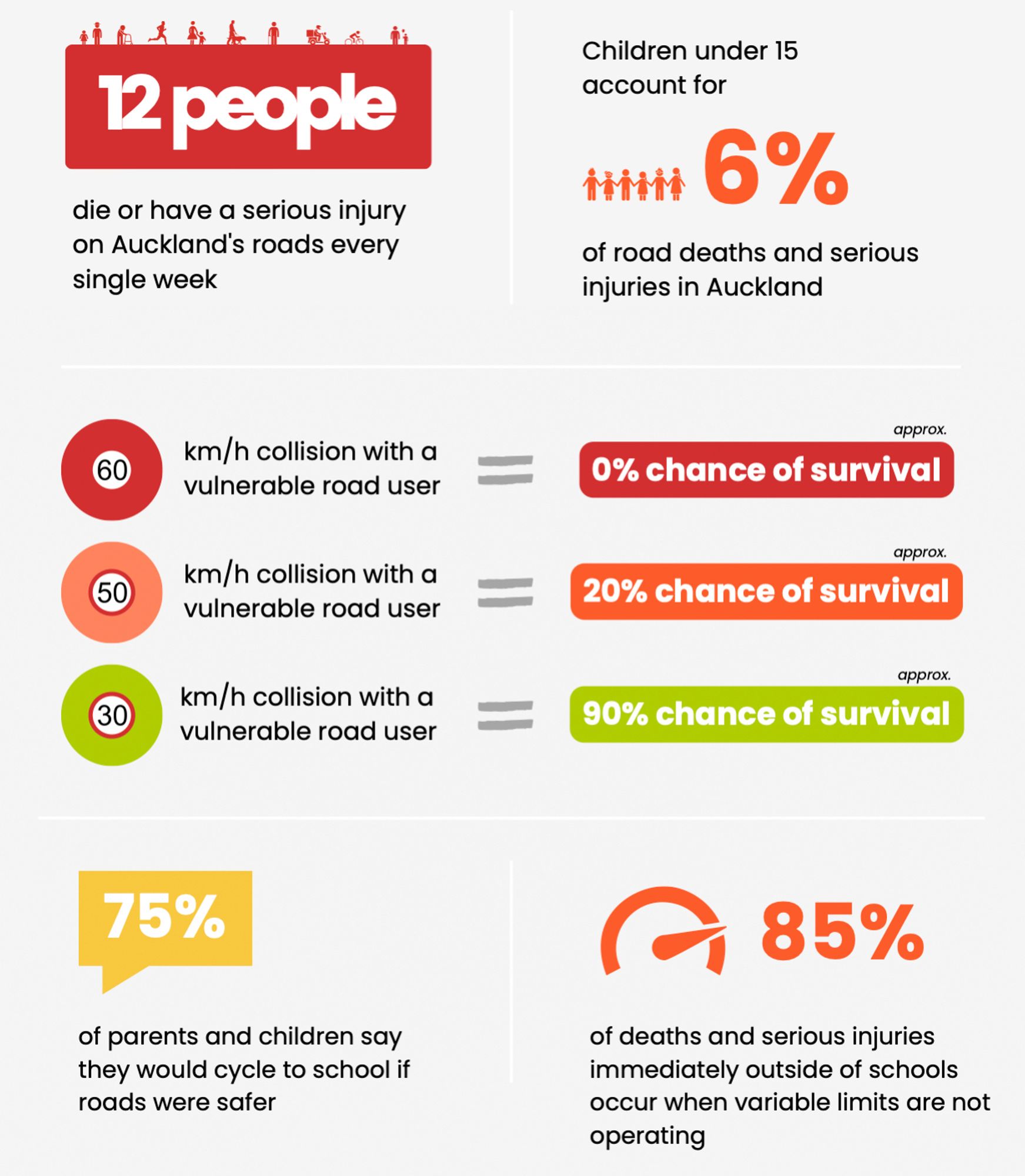
Meanwhile, the rest of the world is getting on with it
Worth revisiting this story from last year, on why we need a plan for children, not for motorists:
Drivers are not “under attack” – quite the reverse. For decades, our towns and cities have been designed around the car above all other forms of transport. The results of this have not been great for anyone – choked streets, disconnected communities, failing high streets, obesity and ill health. Most of all, children have (unwillingly, unknowingly) sacrificed their freedom – and in some cases, their lives.
In Europe, cities that are successfully moderating driving speeds find that – surprise surprise – it also generates a better pace of life for everyone: children spend twice as much time playing outdoors, traffic injuries fall, the number of people on bikes rises, and you can hear yourself think.
In Wales, a leading vehicle insurer notes that car damage claims have fallen 20% since nationwide 20mph speed limits were introduced last September. Won’t somebody think of the panel-beaters!
In Ireland, local elections have confirmed strong support for progressive streets policies, reports IrishCycle: “Supporters of pedestrianisation, cycle routes, and bus priority measures have won seats in most areas where the issues became local election battlegrounds in Dublin.”
In London, the first low-traffic neighbourhood in London takes stock of its successes, ten years on:
“I laugh when I think back to when I drove from Highams Park to the shops in Walthamstow,” said Maureen Barry. “It’s less than a 25-minute walk. I’d never even consider it now.”
…
Steve went on to perhaps sum up the general opinion on low traffic schemes better than anyone. “There’s two sides of my story,” he added. “As a driver it’s a pain in the arse, but for ordinary people it makes the place better.
Which brings us to Paris: you’ll never guess the ‘one simple trick’ the French capital used to reduce air pollution 40% ahead of the Olympics… Okay, you probably guessed it. Anyway here’s a taste of it:
Public transport is a public good
A good piece by Dr Tim Welch in Newsroom, encouraging feedback on the RLTP and pointing out the immense social value of a well-functioning public transport system:
Public transport isn’t just something people use when they can’t drive or won’t drive; it’s a critical lifeline for a massive part of our population, connecting the far corners of the city and services like schools, grocery stores, doctors’ offices, and work. For many, it is not only a form of transport, but upward economic mobility, for individuals and their families.
Get on the bike bus and/or bike train
A nice read from the Washington Post about the rise of bike buses, known here as bike trains, which help support a critical mass of kids to get to school in a way that’s both safe and fun.
“It’s social, people are happy, and it makes my whole day,” Charlotte Mooney, a teacher at Presidio Knolls School, tells me as her son, Sam, rides alongside her.
How did he like joining the bike bus to go to school? “It’s the best way,” Sam says, pedaling through the last of the music and bubbles.
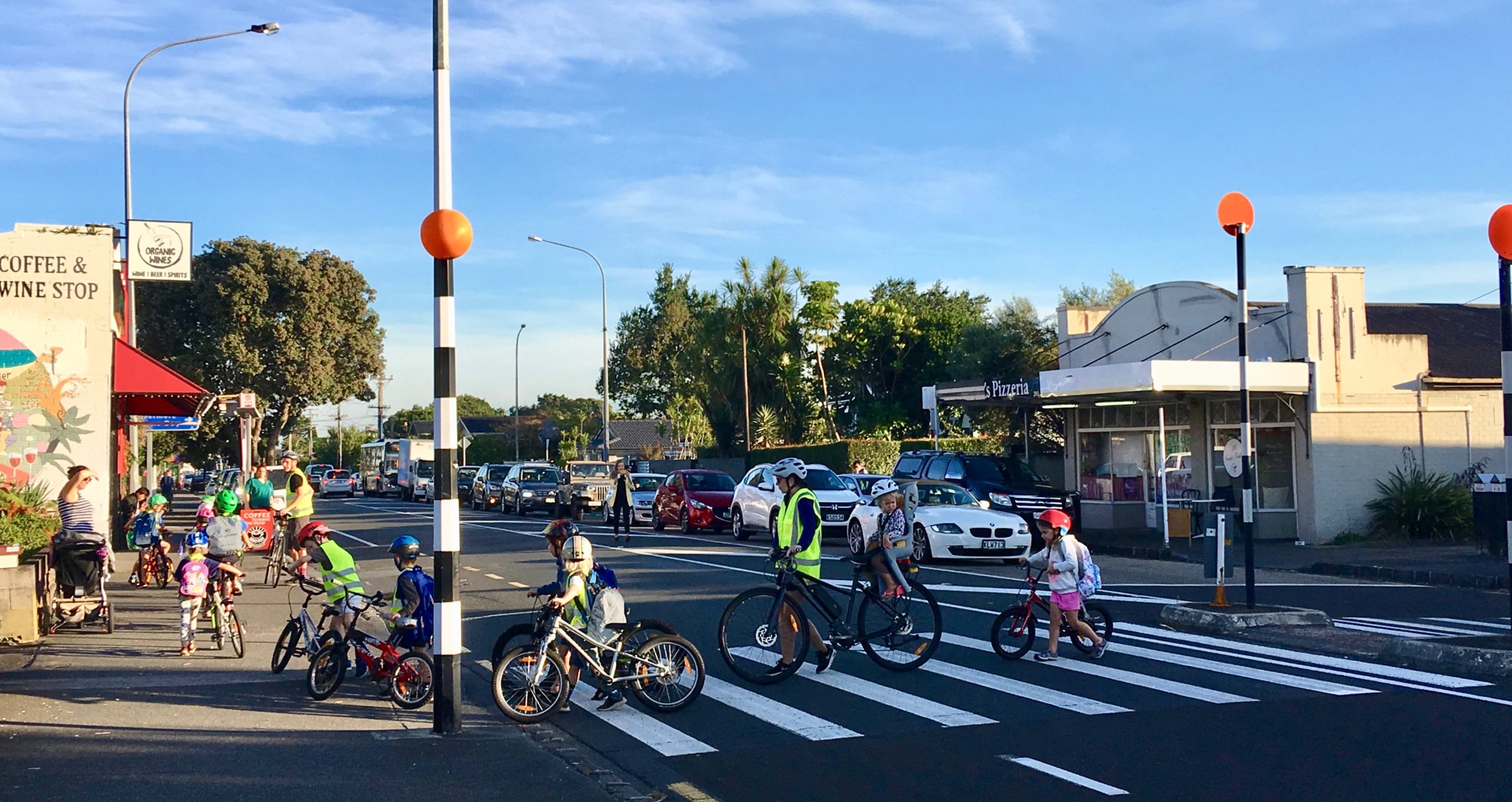
Two great flavours that taste great together
Would you like some urbanism with your climate advocacy? Or vice versa? Then you might like this solid read (the first of a four-parter) from The Urbanist on “land use policy, how it connects with climate change, and why it needs to be part of the solution.”
With this the hottest June in Aotearoa since written weather records began in 1850, we all need to be part of the solution.
What did the mummy volcano say to the baby volcano?
“I lava you.” Related: here’s a fascinating read – and an intriguing listen – about the lava caves beneath the surface of Tāmaki Makaurau. Turns out there are way more of them than you might have imagined:
…the database is growing: over the past two years, previously unknown lava caves have been discovered at an average rate of one per month – often on construction sites, says Kate Lewis, natural features specialist at Auckland Council.
Eye-catching images from the socials
A load of bollards, via Jessica de Heij on Twitter:
“
And from New York, where the Governor of the State pulled a last-minute handbrake turn on congestion pricing for NYC, this striking image from the MTA’s 20-year Needs Assessment. As Shabazz Stuart noted on Twitter, “Last week the governor picked the one on the left.”
From highways to busways
This is super-applicable to our situation. Here’s looking at you, SH16.
And, just in case anyone’s still unclear about “induced demand”…
You build more roads, you get more traffic. Seems obvious, and has been observed to be true for over a century. And yet a belief persists among many people (and indeed governments) that the trick is just to keep widening the roads. From 2022, this article on how to help people understand the paradox of induced demand is worth a re-read.
For our money, the good folk of Utopia did a perfect job of myth-busting the idea of a “Congestion-Busting Master Plan”.
There are plenty of other great explainers, images, analogies and examples out there. What’s your fave? Also from 2022, here’s one we prepared earlier…
Cartoon of the week
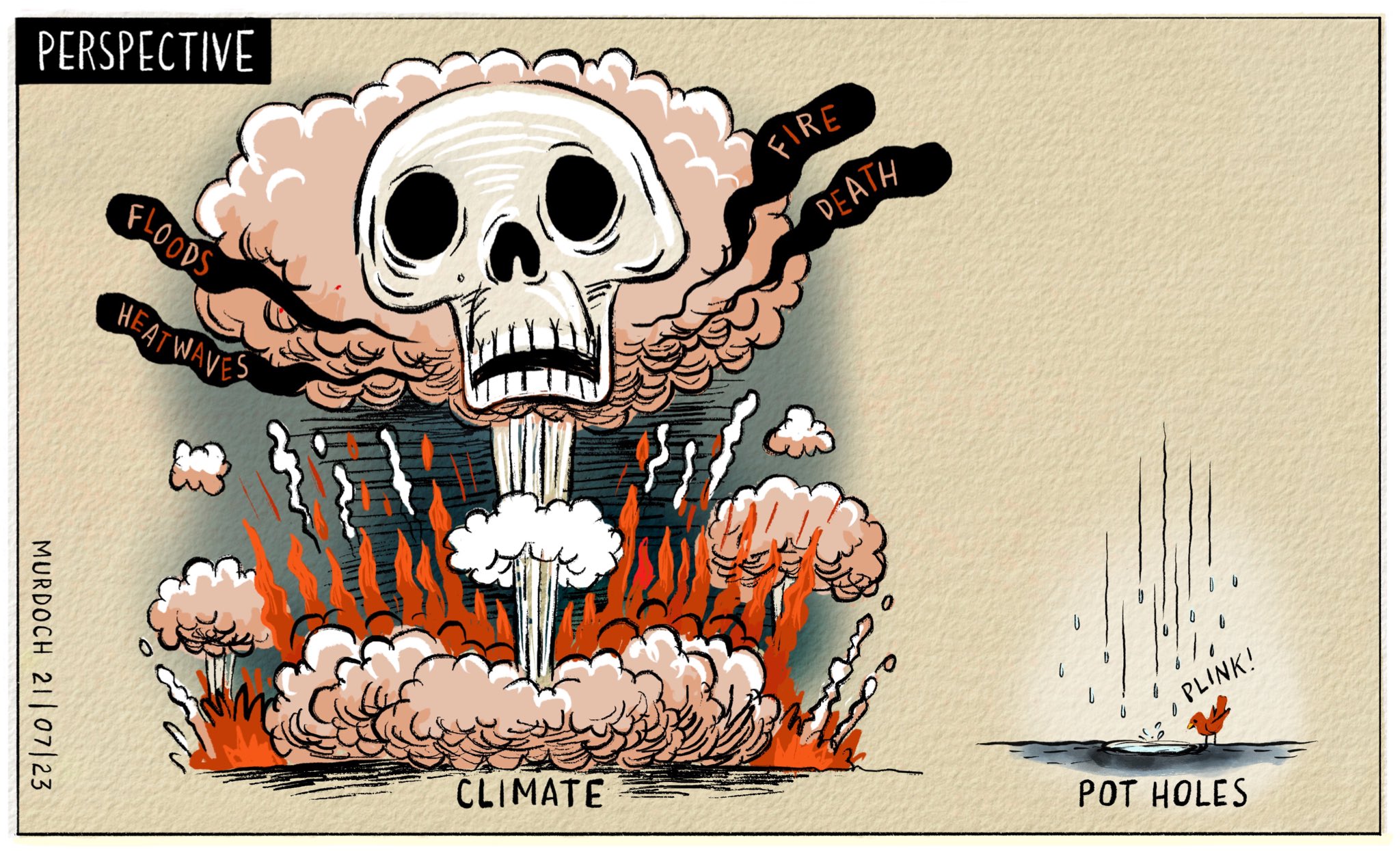
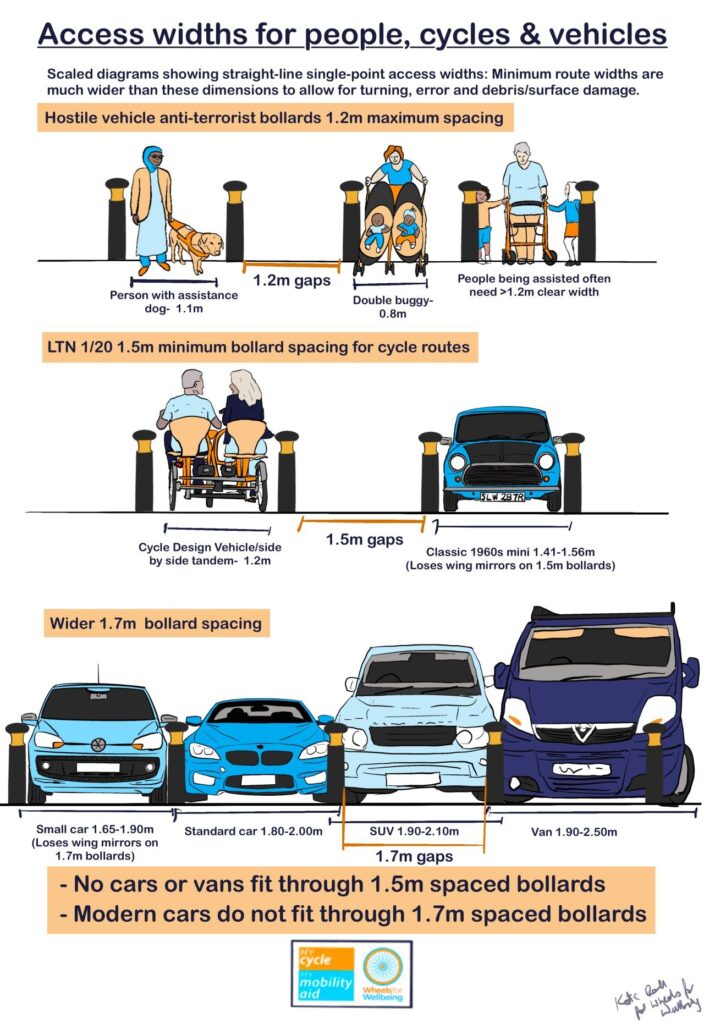
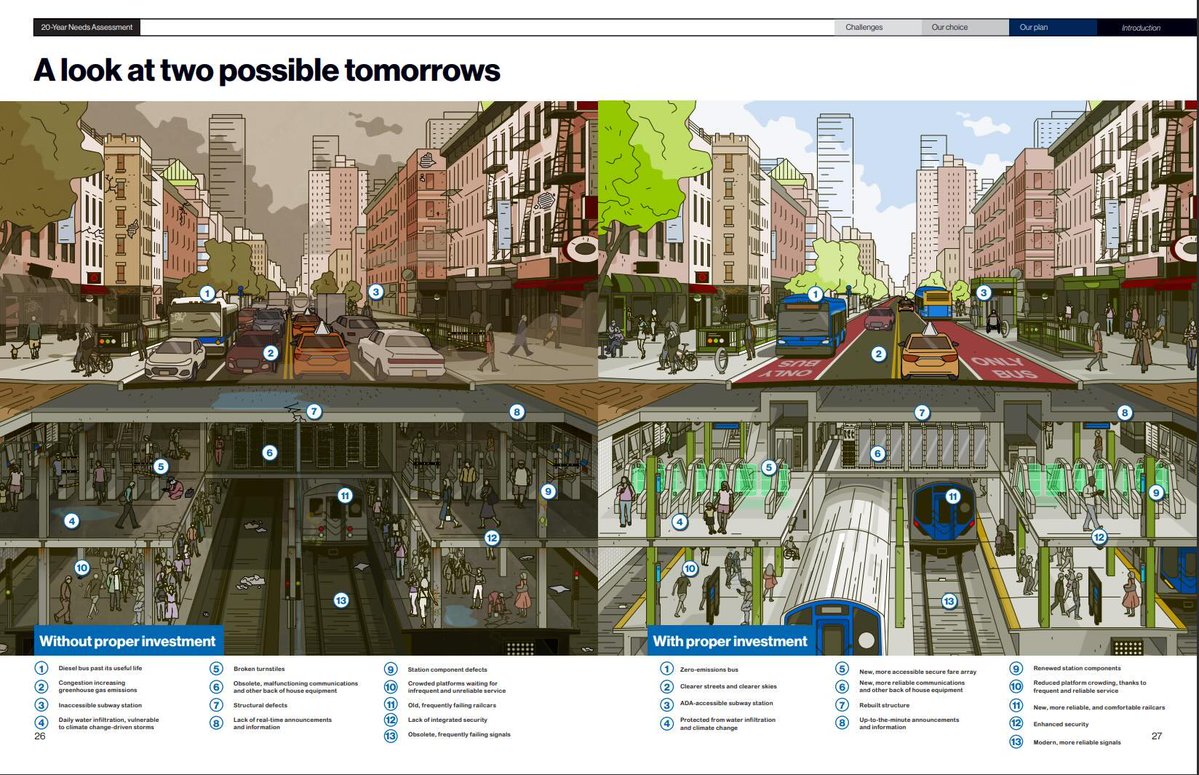


 Processing...
Processing...
Another week, another announcement from Simeon Brown that borders on criminality. But which most people will probably love because a few minutes delay on their journey is more important.
When you buy medicines the packet and the doctor/pharmacist tells you the dosage to take – based on evidence and clinical trials. Yes you may not die if you take more but the risk goes up – no one is campaigning on saying take more medicine are they? Perhaps this is a stupid whatabout argument but why is transport so devoid of evidence based policy and practice?
Presumably this is the first National step, so that when the road toll rises they can funnel money through the road industry to build more 4 lane highways everywhere?
Lets turn Queen Street into a motorway and toll it. Imagine how fast your trip will be off peak.
At least it’s Friday???
(and our chances of surviving this weekend have been reduced by Wellington Politicians)
bah humbug
That muppet that leads ACT was on TV claiming they will base speed limits on evidence not ideology. He wasn’t being ironic and I don’t think he was lying so the only alternative is that he is stupid. The evidence is lower speed limits save lives.
Maybe he means they will base it on political evidence. Higher speeds equals more votes. The evidence is clear. /sigh
In the short (talk radio) term, this may be true. On the other hand, I hold out some hope that forcing such change on local communities will lead to a blow-back effect. Protests, angry parents etc. that may well eventually translate to vote damage for them
Of course that effect will only occur in strong measure if and after the govt actually pushes this all through (most people will be oblivious until after it occurs), and by then the damage will be done.
This government is the most populist government elected in a generation. They simply don’t care about evidence, they care about votes and how to manipulate voters.
Of course he was lying. Lying is what they do, consciously and as a way of political life, because it works on people who don’t know what’s really happening, and it infuriates people who do know what’s really happening.
Those blanket speed limit increases are EVIL. They are a fist (not a slap) in the face of local democracy, and will kill people in droves. New Zealand is already in the back of the queue for road safety in the OECD, this will move us into third world territory.
First the PISS program (Productivity in surburban streets) and now, KKK, (kiwis killing kiwis). Is it all designed towards endless economic growth? More panel beaters. At the extreme end more replacement of vehicles. More work for the medical profession. Has to be great for the economy.
Preceisely!
The govt can propose whatever blanket rules they want as a default. However, local councils have the right to override th speed limits as they see appropriate.
Especially on roads that they pay for! Unless the govermetn wants to NZTA to maintain all our local roads too?
The proposed rule takes away the right of local councils to set sensible speed limits on local roads and imposes a huge cost to change speed limits back or to justify keeping any sensible teductions on the same roads that have already been made safe
120kph on a motorway or expressway is not dangerous.
The UK set its motorway speed limit at 70mph after complaints about excessive speeds being done by Le Mans race car teams on the M1. They set the speed limit to 70mph in 1965 and based it on the stopping distance of a Ford Anglia, a popular car at the time.
Today, even in NZ, there are no Anglias on our roads. The stopping distance of the cars on NZ roads are far shorter than the cars that were around 60 years ago.
In Germany, where quite a few parts of the Autobhan have no limits, the road mortality per 100,000 inhabitant is 3.7 vs NZ 7.8. Per billion vehicle kms Germany is 4.2 vs NZ 7.2 showing that speed is not the issue, driving standards are the problem.
I have driven in Germany, at speeds of close to 300kph and it was probably safer than passing through a traffic light in an Auckland 30kph zone.
That is not the full story with those German Autobahns. Some have no speed limit, but many of the busier ones, and many in more urban areas do. You often have variable speed limits. The thing we have around Auckland, 100km/h speed limits and some variable ones, would be quite usual. There is one crucial difference: if you break those speed limits you will get speeding tickets.
And also the 300km/h thing sounds made up, that would be to dangerous even for German car makers. (the cars over there tend to be speed limited to 250km/h)
What’s with the deleting of my response to this thread?
I just fact checked Roeland that in fact the majority of the German Autobahn system is open speed.
Why was that removed?
You’re really comparing the safety of grade-separated, safety-barriered autobahns with the relative safety of most of NZ’s undivided road network? I think you’ll find too that most German undivided rural roads have lower speed limits than we do (esp around intersections) and most urban streets are 30 or 40kmh. They’re doing most of the heavy lifting for Germany’s road fatality rate (which is still higher than many other parts of Europe).
One of my colleagues was a first responder to an accident on an Autobahn just out of Dortmund ( Go BVB!) . It was winter, snowing, the driver at fault was found to have been going at about 70kmph – they were hammered in the subsequent court case for not driving at appropriate speed for the conditions – thereby causing an accident.
Notable that councils etc will have to perform cost-benefit analyses to change speed limits in the future, but this is not done for the blanket reversal. The consultation document says none of this has been assessed, or the impacts. So who is going to do it?
Simeon spent a few years thinking about it, so it’s good.
Good job that he didn’t over think it.
God told Simeon to do it.
All part of the death cult’s modus operandi.
That is one of my comments to the proposal.
The proposal requires that every change needs a CBA. This is a change, so a CBA is required. No CBA has been done, hence the reversal must be rejected.
The interesting thing is that I have done economic assessments of time vs safety for some speed limit changes. It’s a bit trickier to quantify it well in urban areas (intersections and congestion mess up the speed-change estimates), but in rural areas generally the safety benefits of speeds less than 100kmh comfortably outweigh the relatively minor travel time increases (and I haven’t even factored in the reduced vehicle operating costs at lower speeds too). So Minister Brown might get a bit of a surprise when these things are looked at…
The way I have read this draft proposal is that the government intends to issue a directive to reverse any speed limit implemented by a local authority or the NZTA after 1 January 2020, despite the extensive risk assessments and consultation work undergone to get these approved and enacted.
This is downright irresponsible and dangerous if the government thinks they can override those decisions without requiring road authorities to conduct further speed reviews. For a country with one of the highest rates of road fatalities per capita in the OECD, this is completely wrong approach to road safety. The cost of replacing signage is also a cost the country can do without.
I am not hugely supportive of 120 km/h limits on our motorways either. Not without an initial period of 110 km/h for those that they intend to speed up. The roads may be well designed to reduce the risk of head-on collisions and side impacts but it doesn’t eliminate the risk of high impact crashes.
The only thing that I do agree on, to an extent, is the variable speed requirements around schools. Although this seems to be a blanket approach (something the government specifically campaigned AGAINST), their reasoning is based on estimated times where children are arriving to or departing from school, when activity is at its very busiest. However the international research supports permanent, not variable restricts .Children can be present any time of the day, for reasons such as going home for lunch, after school programmes, or even in weekends to play on the fields or on playground equipment. I support permanent speed reductions around schools on a case by case basis.
Whoah, that HAT statistic: 85% of DSIs outside schools (in Auckland?) happen *outside* those variable speed times?? Clearly, year-round safe speed areas near schools are protecting a whole lot of people 24/7, not just kids arriving at and leaving school!
Aside from its tunnel vision re timing, the huge flaw in the “reasoning” behind this new proposal is the notion that survivable driving speeds should only apply within 300m (total) of the school gate.
Kids and families who walk, bike and scoot (or want to) to school and after-school activities – and kids who walk more than 300m to catch a bus or meet a parent – need safe journeys the whole way, all day and all week.
It’s frankly weird and not very science-y of the minister to decide the laws of physics only apply in a tiny space-time forcefield around the school gate and only from Monday to Friday. The evidence is clear that 30km/h is the speed beyond which collisions between cars and people rapidly become deadly – whether you’re arriving to maths class, crossing the road to football, or going to the dairy.
We deserve strong and coherent evidence-led planning that allows people to live full and healthy lives on our streets and in our neighbourhoods – not the kind of magical thinking that imagines kids only exist or are worth protecting when entering and exiting a car outside a school.
Is there evidence of ramping up speeds slowly vs just increasing changes the safety outcome?
I’m very much in favour of road design for speed. Bar certain situations, such as around a school zone you can reduce traffic speed on a raod that’s usually faster.
Motorways being slowed down during traffic periods to increase flow.
But if you build a road that is 100/130/150, it should feel comfortable at that speed. (of course not in every vehicle)
I’ve driven in Italy/Germany, and I don’t thinka rampup makes sense, going 130 int Italy, or even 170 on some roads in Germany feels comfortable you don’t feel like you’re racing.
Certain restrictions can still apply, such as trucks limits, also trailer speed limit is 90 etc.
130km/hr in Italy is not safe. I had a very close call when the plastic bottom try flew off a flash modern car in front and the merc tailgating me dived into the inside lane so my only option was to hit the brakes in the Panda and try to avoid spinning. Really highlights the stopping distance difference between 100 and 130 in an emergency situation. Lets just say the rest of that drive was in the slow lane!
Sorry feeling comfortable isn’t a great measure of safety. It’s a false sense of security.
I see news reports all the time about the carnage on those roads. Just do a google image search “Incidente autostrada.”
I’m not really opposed to 110 or 120 km/hr on a good motorway but I am in favour of a lot of the 30 km/hr areas which are not major arterials or a lot of people walk & cycle (or try to!) etc. It’s all about the grade separation.
Can’t believe how this government has gone to the extreme in the wrong direction. Must be the only one in the world doing this?
Tolls, user pays, congestion charges – how the Government will make you pay for infrastructure. “So yes, that means congestion charging to manage demand”
https://www.thepost.co.nz/politics/350310288/chris-bishops-big-pitch-more-user-pays-and-private-capital-infrastructure
At least there is one sensible Government Minister.
Maybe we are in a timeline where, in 2050 or so, New Zealand will be the last country on Earth where most of trips are still made in petrol powered cars.
Designing for speed is the way to go, but it’s going to be insane when councils are setting out local roads for 30kph maximum, then are forced by central govt to raise the signage 50. Guarantee there are drivers who will do their best to get to 50 (60) even if the road is designed to be completely unsafe at that speed.
Hopefully as a little push in the right direction, I’d appreciate it if you would “sign” my and my son’s petition on allowing kids and the adults accompanying them to cycle slowly on the footpath. https://petitions.parliament.nz/4a0905e5-77ad-4e5f-538b-08dc7f703e94
There was some more detail about it in last week’s wrap up.
Surely designing new roads to a 120kph standard is just wasteful over design.
The vast bulk of the economic advantages of shorter journey times lies in moving freight, not increasing peak speeds obtained in private motoring.
Increasing heavy vehicle speeds above 100kph is generally uneconomic because of the much increased fuel consumption and wear and tear.
Road safety is considerably enhanced by decreasing the divergence in speeds travelled thus conflicting interactions between vehicles.
Increasing speed limits is just so wrong on so many measures.
It is not the governments job to restore the exhilaration of driving at the expense of lives lost.
Simeon Brown clearly watched too much Top Gear as a kid, and hasn’t grown up since then.
This is surely one of the worst government policies ever released. The increased deaths and serious injuries from it will be able to be calculated – someone should request the information from the NZTA safety team (before they all lose their jobs).
Just awful.
Surely transport officials have an ethical obligation to not comply with something they know will kill people?
yes
“reduce your speed (driving over the speed limit can increase fuel consumption by 10%)” says https://www.nzta.govt.nz/vehicles/choosing-the-right-vehicle/fuel-efficient-driving/, so increasing the speed limit must add at least 10% to fuel consumption.
If faster speeds create joy, why aren’t we getting 350k/h high speed trains? Why only 120?
“Traffic Volumes have increased along
SH16 since widening was completed”
Cool now do how many more people live in West Auckland. Also do how many users are people using the WR instead. Actual induced demand on this route is likely to be very minimal.
Here we go, almost atomic bomb proof trams: